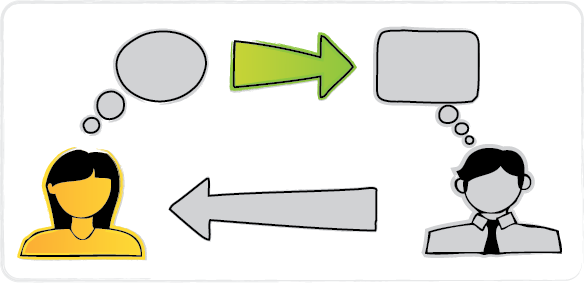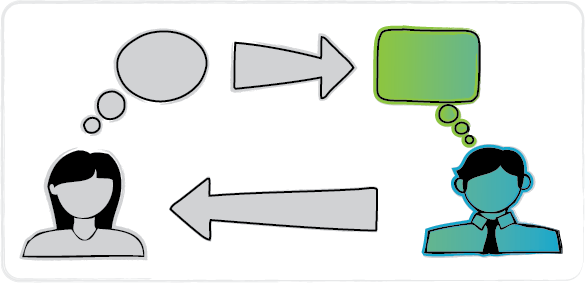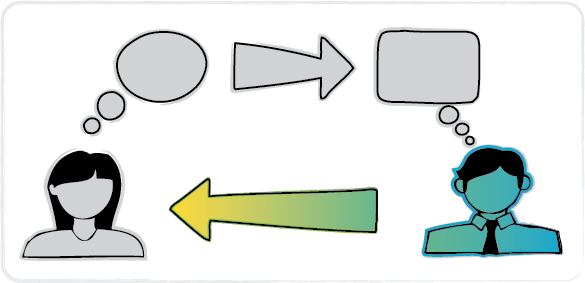
Think about what you did at work yesterday; make a mental catalog of the work-related activities that occupied your time in the last 24 hours. Be specific. Did you get sucked into the world’s longest email chain? Did you have a hit-and-run hallway conversation with your boss? Did you sit through yet another mind-numbing meeting? Or maybe you finally got around to accepting all the LinkedIn invitations that have been clogging up your inbox? Regardless of the task, I imagine they each have something fundamentally in common: communication.
As a learning professional who has untangled her fair share of work-related messes, I believe that becoming an effective communicator will help improve almost every area of your work day. This is no small task. It requires hard work. But, once you start being intentional about small changes in how you communicate, you’ll immediately reap the benefits.
So, let’s go back to basics and learn how to do that. Any communication — whether we’re talking face-to-face, by telephone, email, text, memo, fax, or chiseled stone tablets — takes place between a Sender and a Receiver. Both parties have responsibilities. The Sender’s job is encoding the message and choosing the channel, while the Receiver’s job is decoding the message and giving feedback to the Sender. This process is called The Communication Loop.
Step 1: The Sender Encodes the Message

The Sender encodes when she takes the idea she wants to communicate and puts that idea into words, gestures, or symbols that can be understood by her Receiver. Encoding occurs every day, all the time, and very, very quickly (almost thoughtlessly). Our brains have lots of practice at putting our ideas out into the world.
Step 2: The Sender Chooses the Channel

Next, the Sender chooses the channel. Unfortunately, I’m not talking about HGTV, the best TV channel in existence. The “channel” refers to the method used to send the message: verbal, email, telephone, text, or even frantic gesturing. Mistakes happen often in the communication loop because the Sender chooses the wrong channel. Not every channel is appropriate for every situation! Don’t use an email or a group meeting to address a sensitive issue. Don’t request a dozen individual face-to-face meetings to communicate next month’s project timeline change. And, most important, don’t use the fax machine to ask someone how their day is going. Choose the channel that’s appropriate for your context.
Step 3: The Receiver Decodes the Message

After receiving the encoded message through a certain channel, the Receiver decodes the message. This isn’t always a walk in the park. As husbands everywhere know, the question, “Isn’t it your turn to clean the dishes?” isn’t really a question, and the way a husband decodes that question has a great impact on his relationship for the next few hours. Let me reiterate: communication is hard. Some people are great at decoding. Some aren’t.
Step 4: The Receiver Provides Feedback

Finally, when the Receiver decodes the message, he must send feedback to the Sender. Feedback lets the Sender know whether the message received was the one they intended to send. The Receiver may nod to provide feedback. They may flash a smile. Sometimes, feedback may involve a painful line of questioning. The best Receivers provide effective and comprehensive feedback. The best Senders watch for and respond appropriately to that feedback.
The communication loop happens so frequently and so thoughtlessly, we often make the mistake of never considering it at all. But, when we’re intentional about each step of the process, we make everyone else’s job that much easier. We save our colleagues time, improve our supervisor’s efficiency, and eliminate frustration from our direct reports.
It’s time for a little honesty. Let’s do some self-evaluation. Which stage of the communication loop do you consider your greatest strength?
[polldaddy poll=7723632 align=”center”]
Which step could use some improvement?
[polldaddy poll=”7723646″]
Becoming an effective communicator doesn’t happen overnight. In the weeks to come, I’m going to offer five vital communication tips that encourage clarity between the Sender and Receiver. We’ll cover everything from dealing with business slang to quieting your inner monkey (that’s everyone’s favorite!). I will post a new article about each tip on a monthly basis.
In the meantime, as you work through your daily tasks, be intentional. Select the clearest words and the most effective channel. Listen well, and provide appropriate feedback.
About the author

